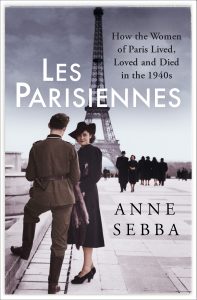Why I Wrote Les Parisiennes
 In an early – and discarded – draft of the prologue to my book I wrote how one of the most common questions every author is asked when publishing a book is: ‘How long did it take you to write?’ If it did not sound so arrogant, I might this time be tempted to reply ‘all my life’. I was born in the shadow of World War Two, just a few years after the events recounted in this book.
In an early – and discarded – draft of the prologue to my book I wrote how one of the most common questions every author is asked when publishing a book is: ‘How long did it take you to write?’ If it did not sound so arrogant, I might this time be tempted to reply ‘all my life’. I was born in the shadow of World War Two, just a few years after the events recounted in this book.
My life was indirectly shaped by them as my father fought in France for the liberation of the country and we often took family holidays driving through France, which we considered a victim country, but never Germany. At university I gave depth to the childhood anecdotes from these years by specialising in studying France in the 1930’s and will never forget my professor dramatically re-enacting for us the tragedy of Léon Blum, the French socialist Jewish prime minister of 1936, who was attacked by a right-wing mob one evening as he emerged from the opera in his evening dress, themes of culture, class, religion, nationalism and fear all swirling around the figure lying prostate on the floor in Bloomsbury.
That’s the long answer to the question of why I wrote Les Parisiennes. I have always been interested in wartime French history and knew that it was about time for some revisionism insofar as the activities of women were concerned.
The short version is that after my book on Wallis Simpson, That Woman, my publishers (not I) would have rather liked a second instalment. However, as any author will tell you, a book doesn’t end with publication. It takes on a life of its own as readers, emboldened by the authority of print, send you new information. For me, one of the most pressing post-publication calls came from Van Cleef & Arpels who asked me why I had not used more photographs of their jewellery in my biography of Wallis instead of all those Cartier jewels? I replied that this was a biography not a coffee table tome about jewellery but I’d be happy on my next visit to Paris to come and talk to them.
Which is how I learned about this fascinating company, rival to Cartier, founded by two Jewish families and by the outbreak of Wars run by an only daughter, born Rachel van Cleef but now a widow who went by the name of Renée Puissant. Hearing the story of Rachel, a glamorous Parisienne who at one point seemed to have everything in life, yet who threw herself out of a window in Vichy – the spa town that became home to the collaborationist government of Marshall Petain in 1942 – was my immediate hook.
I came home from this trip with a burning desire to know: why was Renee Puissant driven to the edge and what deals were necessary for Jewish as well as Catholic women, mothers or daughters, prostitutes and actors? How did women survive in occupied France? Was making a deal the same as collaboration and above all – what would I have done?
 And so the research trips to Paris began, mostly a couple of days a month for the first two years as one ‘contact’ led to another and when there were no more people to meet (after all I’m a journalist at heart so always prefer a live interview to a dead person’s diary) I visited the numerous archives and libraries to read diaries, letters, contemporary books and magazines. Slowly a complicated picture was emerging.
And so the research trips to Paris began, mostly a couple of days a month for the first two years as one ‘contact’ led to another and when there were no more people to meet (after all I’m a journalist at heart so always prefer a live interview to a dead person’s diary) I visited the numerous archives and libraries to read diaries, letters, contemporary books and magazines. Slowly a complicated picture was emerging.
Women in France did not have the vote until 1946 nor did they have bank accounts nor the right to have jobs without the permission of husbands and fathers nor to wear trousers and yet, come the war, I realised they played a far greater part than their pre-war social position allowed. Paris, emptied of men who were either prisoners or in hiding, became a feminised city.
It was women who interacted with the German occupier on a daily basis. I liked the book I was charged to write even more than I realised I would as I discovered women in their 90’s now wanting to tell their stories before they died, women who had not talked about the war before for a variety of reasons and male historians had largely not written about them often because they had not been part of a formal resistance group.
But at the same time I found that what happened here during the 1940’s has left scars of such impenetrable depth that some would still not talk about ‘The Dark Years,’ more than seventy years after the conflict ended. I was repeatedly warned to take into account that what I saw as history was still the highly sensitive present for many.
Almost all who did agree to talk often began by telling me: “Ah, c’est très compliqué…” Very often, once we started speaking, it became clear that the choices they made during this decade had much to do with what happened to them or their parents during the previous conflict, World War One, or even before that, the war of the 1870’s. The deep-seated mistrust of their German neighbour was ingrained; naughty French children were often reprimanded with the refrain: ‘if you don’t behave, the Boche will come and take you.’ But I like listening so I heard them out.
I wanted to end my book in 1949 with the French recovery and the US funded Marshall Plan, so inextricably tied up with German recovery and the beginnings of the European Union. For the past seventy years there has been peace between the two countries which seemed a perfect time to examine women’s role in preventing Nazi domination. It sometimes fell short of what was required but then it often demanded more complex moral choices than the role faced by many of the men.
—
What did it feel like to be a woman living in Paris from 1939 to 1949? These were years of fear, power, aggression, courage, deprivation and secrets until – finally – renewal and retribution. Even in the darkest moments of Occupation, glamour was ever present. French women wore lipstick. Why?
It was women who came face to face with the German conquerors on a daily basis – perhaps selling them clothes or travelling alongside them on the metro, where a German soldier had priority over seats. By looking at collaborators to resisters, actresses and prostitutes, as well as teachers and writers, including American women and Nazi wives, spies, mothers, mistresses, fashion and jewellery designers – Anne Sebba shows that women made life-and-death decisions every day, and, in an atmosphere where sex became currency, often did whatever they needed to survive. Her fascinating cast includes both native Parisian women and those living in Paris temporarily: American women and Nazi wives, spies, mothers, mistresses, and fashion and jewellery designers. Some like the heiress Béatrice Camondo or novelist Irène Némirovsky, converted to Catholicism; others like lesbian racing driver Violette Morris embraced the Nazi philosophy; only a handful, like Coco Chanel, retreated to the Ritz with a German lover.
In enthralling detail Sebba explores the aftershock of the Second World War. How did women who survived to see the Liberation of Paris come to terms with their actions and those of others? Although politics lies at its heart, Les Parisiennes is the first in-depth account of the everyday lives of women and young girls in this most feminine of cities.
—
Anne Sebba read History at King’s College London then joined Reuters as a foreign correspondent based in London and Rome. She is the acclaimed author of Jennie Churchill: Winston’s American Mother, the international bestseller That Woman: The Life of Wallis Simpson, Duchess of Windsor and seven other works of non-fiction. She is married with three children.
Visit her website at www.annesebba.com
Category: Contemporary Women Writers, On Writing































Comments (1)
Trackback URL | Comments RSS Feed
Sites That Link to this Post